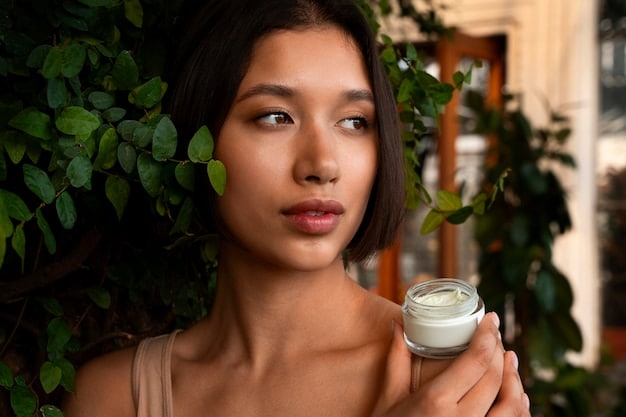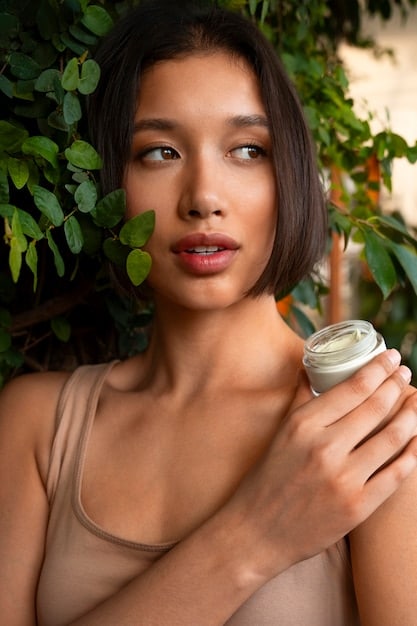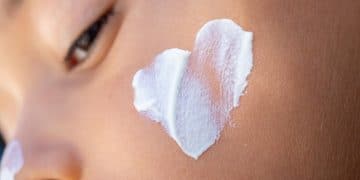The Best Skincare Routine for Oily Skin: A Comprehensive Guide

Anúncios
A comprehensive skincare routine for oily skin involves gentle cleansing, targeted treatments like salicylic acid, consistent hydration with lightweight formulas, and daily sun protection to manage excess oil, reduce breakouts, and maintain a healthy complexion.
Navigating the complexities of oily skin can often feel like a constant battle against shine, breakouts, and enlarged pores. Developing The Best Skincare Routine for Oily Skin: A Comprehensive Guide is not merely about drying out the skin, but rather achieving a delicate balance that respects its natural functions while mitigating common concerns. This guide delves into the science and practical steps necessary to transform your complexion, offering insights that move beyond anecdotal advice to truly address the unique needs of oily skin.
Understanding oily skin: causes and characteristics
Oily skin is characterized by an excessive production of sebum, the natural oil produced by the sebaceous glands. This overproduction can lead to a greasy appearance, enlarged pores, and a higher propensity for acne breakouts. Recognizing these characteristics is the first step in formulating an effective skincare strategy.
Several factors contribute to oily skin. Genetics play a significant role; if your parents have oily skin, you are more likely to inherit this trait. Hormonal fluctuations, particularly during puberty, menstruation, or pregnancy, can also stimulate increased sebum production. Stress is another common culprit, as it can trigger a rise in androgen hormones, which in turn boosts oil production. Environmental factors, such as humidity and heat, often exacerbate the oily appearance, making proper management even more crucial.
Common characteristics of oily skin
- Shiny or greasy appearance: Especially in the T-zone (forehead, nose, and chin) throughout the day.
- Enlarged pores: Pores often appear more visible due to the accumulation of sebum and dead skin cells.
- Acne vulnerability: Higher likelihood of developing blackheads, whiteheads, papules, and pustules.
- Thicker skin texture: Oily skin can sometimes feel thicker and less supple compared to other skin types.
Addressing these fundamental aspects requires a targeted approach, focusing on gentle yet effective cleansing, oil regulation, and maintaining skin barrier integrity. Understanding the root causes allows for a more personalized and successful routine.
The foundational steps: cleansing and toning
The cornerstone of any effective skincare routine, especially for oily skin, begins with thorough yet gentle cleansing and balancing toning. Many with oily skin might be tempted to use harsh cleansers that strip the skin of its natural oils, believing this will reduce shine. However, this often backfires, leading to reactive sebum overproduction and further irritation.
For cleansing, opt for a gentle, foaming cleanser that effectively removes excess oil, impurities, and makeup without disrupting the skin’s natural barrier. Look for ingredients like salicylic acid (BHA) or glycolic acid (AHA) if you also experience breakouts or blackheads, as these can provide a mild exfoliation. Cleanse twice daily: once in the morning to remove overnight sebum and product residue, and once in the evening to wash away the day’s accumulation of dirt, makeup, and pollutants.
Following cleansing, toning plays a crucial role in rebalancing the skin’s pH, removing any residual impurities, and preparing the skin for subsequent treatments. Avoid toners containing high concentrations of alcohol, which can be overly drying and lead to irritation. Instead, select toners with ingredients like witch hazel (alcohol-free), niacinamide, or salicylic acid, which help reduce oil and refine pore appearance without stripping the skin.
A well-selected toner can also provide a light layer of hydration or deliver active ingredients that further benefit oily skin. The goal is to create a clean, balanced canvas for the next steps in your routine, ensuring that your skin is receptive to the beneficial ingredients that follow. This dual approach of cleansing and toning sets the stage for a healthier, less oily complexion.
Targeted treatments: serums and exfoliants
Once cleansed and toned, oily skin greatly benefits from targeted treatments that address specific concerns such as excessive oil production, large pores, and breakouts. This step often involves the strategic use of serums and exfoliants, each designed to deliver potent active ingredients directly to the skin.
For oil control and pore refinement, serums containing niacinamide are highly effective. Niacinamide, a form of vitamin B3, helps to regulate sebum production, reduce inflammation, and improve skin barrier function, leading to a less oily and more uniform complexion. Another powerful ingredient is zinc, often found in combination with niacinamide, which further aids in oil regulation and has anti-inflammatory properties beneficial for acne-prone skin.
Exfoliation is critical for oily skin to prevent the build-up of dead skin cells and sebum within the pores, which can lead to blackheads, whiteheads, and acne. Beta Hydroxy Acids (BHAs), specifically salicylic acid, are highly recommended for oily and acne-prone skin because they are oil-soluble, allowing them to penetrate deep into pores to dissolve sebum and cellular debris. Alpha Hydroxy Acids (AHAs), such as glycolic or lactic acid, can also be beneficial for exfoliating the skin’s surface, improving texture, and reducing hyperpigmentation.
Key active ingredients for oily skin treatments
- Salicylic Acid (BHA): Penetrates oil to clear pores, reduces blackheads and breakouts.
- Niacinamide: Regulates sebum, reduces inflammation, minimizes pore appearance.
- Zinc PCA: Further reduces sebum and has antibacterial properties.
- Glycolic or Lactic Acid (AHA): Exfoliates surface skin to improve texture and tone.
It’s important to introduce these treatments gradually, especially potent active ingredients, to allow your skin to adjust and prevent irritation. Starting with lower concentrations or applying them every other day can help gauge your skin’s tolerance. Consistency is key, but so is listening to your skin’s needs to avoid over-exfoliation or dryness.
Hydration and moisture: choosing the right products
A common misconception swirling around oily skin is that it doesn’t need moisturizer. This couldn’t be further from the truth. In fact, depriving oily skin of moisture can backfire, prompting the sebaceous glands to produce even more oil to compensate for the dryness. The key lies in selecting the right type of hydrating products.
For oily skin, lightweight, non-comedogenic (meaning they won’t clog pores) moisturizers are paramount. Look for gel-based or fluid formulas that absorb quickly without leaving a greasy residue. Ingredients like hyaluronic acid are excellent as they provide hydration by drawing moisture into the skin without adding extra oil. Glycerin is another humectant that offers similar benefits. The goal is to provide adequate hydration to maintain a healthy skin barrier and prevent dehydration signals that could trigger increased oil production.
In addition to traditional moisturizers, some individuals with very oily skin might find a hydrating serum applied before a lighter lotion to be sufficient. These serums often contain humectants and ceramides, which support the skin barrier. Even in humid climates, a light moisturizer is still necessary to lock in the hydration from previous steps and protect the skin from environmental stressors.
Ideal moisturizer characteristics for oily skin
- Non-comedogenic: Ensures the product won’t clog pores, reducing the risk of breakouts.
- Oil-free or water-based: Prevents adding unnecessary oil to an already oily complexion.
- Lightweight texture: Gel or fluid formulas absorb quickly and feel breathable on the skin.
- Contains humectants: Ingredients like hyaluronic acid or glycerin draw moisture into the skin.
Don’t forget the importance of an evening moisturizer. While daytime moisturizers often include SPF, nighttime allows for products focused purely on repair and hydration. A lightweight night cream or gel can help restore the skin barrier while you sleep, preparing it for the next day. Proper hydration is a critical, yet often overlooked, step in managing oily skin effectively and maintaining its overall health.

Sun protection for oily skin
Sun protection is a non-negotiable step in any skincare routine, and for those with oily skin, it presents a unique challenge: finding a sunscreen that offers effective broad-spectrum protection without contributing to shine or clogging pores. Skipping sunscreen can not only lead to premature aging and increased skin cancer risk but can also worsen post-inflammatory hyperpigmentation (dark spots) often seen after acne breakouts.
The primary concern for oily skin types is the feeling and appearance of traditional sunscreens, which can sometimes be thick, greasy, and leave a white cast. Fortunately, advancements in formulations have led to excellent options specifically designed for oily and acne-prone skin. Look for sunscreens labeled “mattifying,” “oil-free,” “non-comedogenic,” or “gel-based.” Mineral sunscreens containing zinc oxide and titanium dioxide are often well-tolerated, as they sit on top of the skin and reflect UV rays, making them less likely to irritate or clog pores. Chemical sunscreens, when formulated for oily skin, can also be lightweight and absorb well.
Applying sunscreen should be the final step in your morning routine, after your moisturizer. It creates a protective shield over the active ingredients applied previously. Reapplication throughout the day, especially after sweating or swimming, is crucial to maintain protection. Many brands now offer tinted sunscreens or those with added oil-absorbing ingredients like silica, which can help control shine throughout the day, doubling as a light makeup base.
Tips for selecting sunscreen for oily skin
- Look for “oil-free” and “non-comedogenic” labels: These indicate the product is less likely to clog pores.
- Opt for mattifying or gel formulas: These textures help control shine and feel lighter on the skin.
- Consider mineral sunscreens: Zinc oxide and titanium dioxide are often gentle and effective for oily, sensitive skin.
- Choose broad-spectrum SPF 30 or higher: Protects against UVA (aging) and UVB (burning) rays.
Incorporating a suitable sunscreen into your daily routine is an essential commitment to long-term skin health, preventing sun damage that could exacerbate existing concerns or create new ones for oily skin. It’s a small step with significant benefits for your complexion.
Lifestyle and dietary considerations for oily skin
While topical skincare is crucial, managing oily skin goes beyond what you apply to your face. Lifestyle and dietary choices can significantly influence sebum production and overall skin health. Ignoring these internal factors can undermine even the most diligent skincare routine.
Diet plays a role, though the direct link between specific foods and oily skin can vary among individuals. Some studies suggest that high glycemic index foods (like white bread, sugary drinks) and dairy products may exacerbate acne in some people, potentially by influencing hormones that stimulate sebum production. Focusing on a balanced diet rich in whole foods, lean proteins, fruits, and vegetables can support overall skin health. Omega-3 fatty acids, found in fish and flaxseed, are known for their anti-inflammatory properties, which can be beneficial for acne-prone skin associated with oiliness.
Stress management is another critical component. When stressed, the body releases cortisol, a hormone that can increase oil production. Incorporating stress-reducing activities like meditation, yoga, regular exercise, or simply ensuring adequate sleep can have a noticeable positive impact on your skin. Poor sleep can disrupt hormonal balance, potentially worsening oily skin conditions. Exercise, in moderation, also helps improve circulation and reduces stress, contributing to a healthier complexion.
Maintaining proper hydration by drinking enough water throughout the day is also important. While it won’t directly stop oil production, adequate water intake supports overall bodily functions, including skin health, making it appear more radiant and less prone to issues caused by dehydration.
Lifestyle adjustments for healthier, less oily skin
- Balanced diet: Emphasize whole foods, limit high glycemic index foods and excessive sugar.
- Hydration: Drink plenty of water throughout the day.
- Stress management: Practice relaxation techniques, ensure sufficient sleep.
- Regular exercise: Improves circulation and stress levels.
It’s about adopting a holistic approach. While topical products address the symptoms and surface issues, integrating healthy lifestyle and dietary habits supports the skin from within, creating a more sustainable and effective strategy for managing oily skin in the long run.
Advanced treatments and professional insights
For those whose oily skin concerns persist despite a consistent at-home routine and lifestyle adjustments, sometimes advanced treatments and professional guidance can offer significant improvements. Dermatologists and licensed aestheticians can provide deeper insights and access to treatments not available over the counter, tailoring solutions to individual needs.
Professional chemical peels, for instance, can be highly effective for oily and acne-prone skin. Peels utilize higher concentrations of acids like salicylic, glycolic, or lactic acid to deeply exfoliate the skin, de-clog pores, reduce oil production, and improve skin texture and tone. These treatments should always be performed by a qualified professional to ensure safety and optimal results. Microdermabrasion is another option that physically exfoliates the skin, helping to reduce the appearance of enlarged pores and improve overall texture.
For persistent or severe acne associated with oily skin, a dermatologist might prescribe oral medications such as isotretinoin (for severe cases) or antibiotics, or topical prescription retinoids. Retinoids are particularly powerful for oily skin as they help normalize cell turnover, preventing clogged pores and indirectly controlling oil production over time. Laser and light therapies (like Blue Light Therapy) can also target acne-causing bacteria and reduce inflammation, offering another avenue for treatment.
Beyond treatments, a professional consultation can accurately diagnose underlying conditions that may contribute to oily skin, such as hormonal imbalances, and recommend blood tests or further investigations if necessary. They can also fine-tune your at-home routine, suggesting medical-grade skincare products that contain higher concentrations of active ingredients than typical over-the-counter options.

Seeking professional advice provides a personalized approach, often leading to more effective and lasting solutions for managing oily skin concerns. It’s about bridging the gap between at-home care and expert intervention when the complexity of the condition demands it.
| Key Aspect | Brief Description |
|---|---|
| 💧 Gentle Cleansing | Use foaming or gel cleansers twice daily for effective oil removal without stripping. |
| 🧪 Targeted Treatments | Incorporate salicylic acid, niacinamide, or retinoids to manage oil and breakouts. |
| 💧 Lightweight Hydration | Opt for oil-free, gel-based moisturizers to hydrate without adding greasiness. |
| ☀️ Daily SPF | Apply a non-comedogenic, mattifying sunscreen daily to prevent sun damage. |
Frequently asked questions about oily skin
Your skin can become oily quickly after washing if your cleanser is too harsh, stripping away natural oils. This triggers your sebaceous glands to produce more oil to compensate, creating a rebound effect. Using a gentle, pH-balanced cleanser and not over-washing can help regulate oil production.
While not universally true for everyone, certain dietary factors might influence oily skin. High-glycemic-index foods and dairy products have been linked to increased sebum production and acne in some individuals. Focusing on a balanced diet rich in whole foods and omega-3s is generally recommended for overall skin health.
Absolutely yes. Oily skin still requires hydration to maintain a healthy skin barrier. Skipping moisturizer can lead to dehydration, signaling your skin to produce even more oil. Opt for lightweight, non-comedogenic, gel-based, or oil-free formulas that provide hydration without adding greasiness.
For most with oily skin, exfoliating 2-3 times a week is sufficient. Over-exfoliation can disrupt the skin barrier, leading to irritation and potentially increased oil production. Use gentle chemical exfoliants like salicylic or glycolic acid, and adjust frequency based on your skin’s response.
Some natural ingredients like witch hazel (alcohol-free) or green tea extract can offer benefits due to their astringent or anti-inflammatory properties. However, their efficacy can vary, and they may not be sufficient for severe concerns. Always patch test and avoid harsh DIY solutions that can irritate or strip the skin.
Conclusion
Cultivating The Best Skincare Routine for Oily Skin: A Comprehensive Guide is an ongoing journey of understanding, consistency, and adaptation. It demands a delicate balance of effective oil control, proper hydration, and diligent protection, all while being mindful of internal and external factors. By thoughtfully selecting products and embracing a holistic approach that includes lifestyle awareness, individuals with oily skin can achieve a clearer, more balanced, and healthier complexion, transforming what often feels like a challenge into an opportunity for radiant skin.





